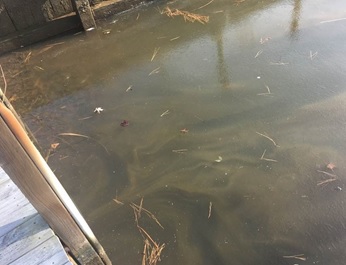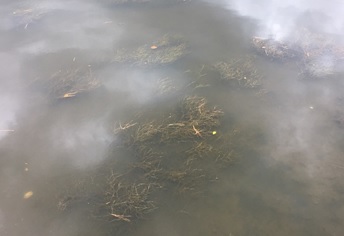
Facebook Twitter Instagram YouTube RSS Feed
Written on: September 17th, 2020 in Outreach
By Michael Bott, DNREC Watershed Assessment and Management Section
Delaware’s Inland Bays (Rehoboth Bay, Indian River Bay, and Little Assawoman Bay) are home to many familiar animals such as finfish, crabs, and clams. But did you know that in addition to these aquatic animals, the Inland Bays are also home to many types of aquatic plants? Just like plants on land, these aquatic plants serve as the first link in the food chain and are foundational to the health of the underwater ecosystem. However, just like weeds in a garden, certain types of these aquatic plants can choke out other beneficial species if allowed to grow out of control.
These aquatic plants can be divided into three categories: macroalgae (“big algae”), planktonic algae (“little algae”), and submerged aquatic vegetation (“SAV”). While all three are essential components of the aquatic ecosystem, when present in large concentrations, both big and little algae can harm the ecosystem as well as constitute a nuisance to human enjoyment of the bays. For this reason, efforts are underway to control algae growth in the Inland Bays by limiting the runoff of nutrients from septic systems, lawn fertilizer, pet waste, and other sources into the bays. SAV, on the other hand, is the target of efforts to restore seagrass beds that have been decimated over the past several decades by poor water quality. In the Inland Bays watershed, the target levels of nitrogen and phosphorus in the water are based on the ability of the estuary to support the growth of SAV.
Since these aquatic plants have a big impact on the health of the Inland Bays ecosystem, these efforts to control big and little algae and then to restore SAV beds are critical to improving water quality so that humans and animals alike can continue to benefit from our Inland Bays. Let’s learn more about each of these three categories of aquatic plants in Delaware’s Inland Bays, and then learn about what you can do to help!
Have you ever been wading or boating in Delaware’s Inland Bays and found yourself knee-deep in algae or found it wrapped around the prop of your boat? The culprits are macroalgae species such as Ulva, Gracilaria and Agardhiella, which in summer months commonly form large mats on the shore or in the shallow water of the Inland Bays.
Although macroalgae provides beneficial habitat to aquatic animals, at high densities it is very harmful to the Inland Bays ecosystem. When excess nutrients run off the land into the water, they act like a fertilizer for the macroalgae, allowing it to take over the bays just like weeds in a garden. The resulting high densities of macroalgae can smother aquatic animals and the beneficial SAV, as well as constitute a nuisance for people trying to enjoy the water.

Discolored water under the ice caused by a widespread phytoplankton bloom in January 2019 (residential lagoon, Rehoboth Bay). Large phytoplankton blooms that color the water brown or green are very common during the summer, but these blooms can occur year round under the right conditions.
You may have also noticed that during the winter months the water normally seems very clear, but that during the summer the water appears very cloudy. Sometimes this is caused by rough weather or boats stirring up the water bottom, but often it is caused by microscopic algae blooms known as “phytoplankton” which when found in large numbers discolor the water.
Just like macroalgae, phytoplankton is essential to a healthy ecosystem because it provides food for many species but can easily become too much of a good thing if excess nutrients are introduced into the aquatic ecosystem. While most phytoplankton species are harmless to humans, there are also species that can produce toxins harmful to humans and wildlife, such as the infamous “red tides” that occur in the Gulf of Mexico. In Delaware, the greatest concern is that these large phytoplankton blooms may consume all the oxygen in the water, causing mass fish kills and other harmful effects to wildlife. The discolored water also blocks sunlight, which prevents beneficial SAV from getting the energy it needs to survive.

Widgeon Grass growing in the Town of South Bethany canals during the summer of 2018. This is the species most likely to be encountered in the Inland Bays and can be found in a variety of salinities and waterbodies.
It may seem like all bad news, but there is hope on the horizon. Now for the first time in decades, you may start seeing beneficial SAV in the Inland Bays and its tributaries. If water quality begins to improve, the macroalgae and phytoplankton will have less nutrients to grow out of control. This allows SAV, such as eelgrass and widgeon grass, to receive the light needed to take hold and grow.
Because these beneficial SAV species are rooted instead of drifting throughout the water like algae, they help hold the sediment in place and thereby improve water clarity. SAV also dampens wave energy, reducing erosion of the important wetlands lining the bays. And, if water quality is high enough, these SAV beds eventually can form underwater meadows which provide critical habitat for juvenile fish, crabs, bay scallops and many other marine organisms.
Currently the areas where SAV can be found are located on the State’s shellfish harvesting maps., which can be found at . These maps are constantly updated so if you find an area that you believe is an SAV bed that isn’t on the map, please share it with us (Michael.Bott@delaware.gov) so we can try and protect these important species as they begin to spread to new areas.
If you want to be part of this success story there are simple things you can do to reduce excess nutrients from flowing into the Inland Bays. Just like runoff from rainfall flows over the land into tributaries, water also flows beneath the land, contributing large amounts of excess nutrients to the estuary. Simple actions such as cleaning up pet waste in your yard, applying the correct amount of lawn fertilizer and maintaining your septic system in good working order are things everyone can do to help the health of the Bays. If everyone does what they can to improve water quality, hopefully we can reestablish healthy seagrass meadows and enjoy them for generations to come.